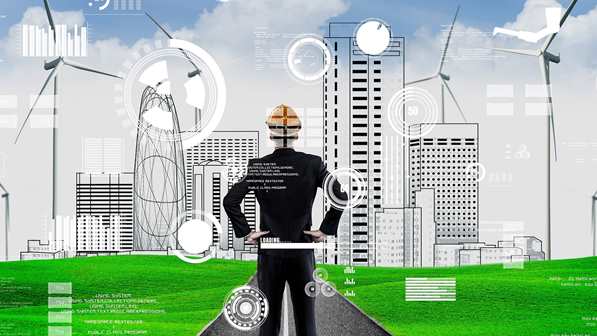
Mark Wilding, Vice President of Global Customer Transformation at ServiceMax, steps into the future and predicts how advances in technology will enable a new era of service delivery.
A few years ago, I heard Kevin Ashton speak at a conference. In addition to being the ‘father of the Internet of Things’, he’s also a futurologist. Among other things, he predicted we will discover extra-terrestrial life in this century – not necessarily little green men, but perhaps bacteria. He also forecasts we will survive climate change and that most people will be vegetarian by the 22nd century. Not as far fetched as it would have been a decade ago.
Predicting the future is a unique skillset, but in some sectors it’s easier than others to see the direction technology is taking us and how it fits with the demands of business. One of the areas this is most visible is in the field service arena.
Technology is ripping up old ways of working and changing how machines are used and serviced. It is also enabling completely new service models and having a significant impact on the skills required and recruitment. This is not going to change. It is going to accelerate. So, where will be in 2030? More of the same or maybe something completely different will emerge? With ‘6G’ already slated for launch in 2030, service as we know it could change.
Here we have outlined our top five predictions for service in 2030.
The metaverse: virtualisation and service
What 6G will bring in 2030 is the sort of data speeds that can turn today’s science fiction into reality. As Marcus Weldon, president of Nokia Bell Labs has suggested, 6G will be a “sixth sense experience for humans and machines,” where applications can deliver on the metaverse and ‘Human 4.0’ vision. Imagine hologram video calls (a bit like in Star Wars but hopefully clearer) and a real-time digital simulation of real-world scenarios.
This is where service comes in. The metaverse can be a more powerful and real-time extension to the idea of digital twins. Field service teams can use the metaverse to train engineers but also trial new parts and experiment with repair techniques. Machines and their environments can be mirrored, monitored and enhanced, giving service teams a real-time simulation and vision. With predictive analytics built-in, it promises to enable more tailored, outcome-centric service models in a more cost-effective way.
Self-service and sustainability: the evolution of product design
Touchless services will be standard by 2030 enhanced by products that have been designed with service in mind. This means an enhancement of what we have already seen through the pandemic – self-service models and remote servicing by engineers. This will enable value-aligned asset lifecycle management, which means less waste, less cost and a more sustainable model.
Sustainability will be a key factor. There are already proposals in place to increase product circularity by using more sustainable materials and design that will enable easier maintenance. For example, the European Union recently revealed a number of measures designed to improve sustainable product design to help governments and businesses reach 2030 NetZero emissions targets.
IoT will be seamless and limitless
“Advances to the industrial internet will be accelerated through increased network agility, integrated AI and the capacity to deploy, automate, orchestrate and secure diverse use cases at hyperscale,” says an Ericsson report The Future of IoT. “The potential is not just in enabling billions of devices simultaneously but leveraging the huge volumes of actionable data which can automate diverse business processes.”
The launch of 6G will enable IoT to deliver on this sort of promise. IoT connectivity will be the standard for industrial machines and devices, increasingly maintained by third party control centres to optimise skills and ensure uptime and scale. It will also accelerate smart urban projects as well as promises of personalised medicine and healthcare.
Automation will enable businesses to run multiple service models
As Gartner suggested in its Future of Field Service Management report, automation and network capacity will enable organisations to deliver multiple service models. Even simultaneously with multiple clients.
A combination of all technology advances will help organisations deliver and maintain tailored scenarios depending on the specific needs of customers. As Gartner says in the report, businesses can deliver services within four specific areas – outcome centric, equipment centric, appointment centric and knowledge centric.
This will require both digital transformation and business model change. Expect service leaders to address challenges such as technician bots, digitally augmented subcontractors and outcome-based contracts with greater velocity.
Field service engineers in short supply
Around half of all existing work activities could be automated in the next few decades, as next-level process automation and virtualisation become more commonplace. However, the role of the field service technician will be highly valued, more specialised and multi-faceted.
Each maintenance challenge will have its specific solution, with engineers working virtually to supplement self-service capabilities or on-site to physically change parts or upgrade machines and devices. Each job will be data-driven, pre-defined and pre-prepared with parts orders automated and delivered.
Given the expected increase in talent shortages – Korn Ferry claims that by 2030, more than 85 million jobs could go unfilled because there aren’t enough skilled people to take them – organisations will have to fight even harder to attract and train talent. Work culture and reputation will be key, as will automation of processes and business alignment.
About the Author
 Mark Wilding is Vice President Global Customer Transformation at ServiceMax.
Mark Wilding is Vice President Global Customer Transformation at ServiceMax.




